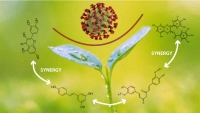How Various Plant Components Can Fight Against Coronavirus
Plants are the rich source of many nutrients that protect them from diseases, heat, radiation, poisons, and pollutants. These phytonutrients also have numerous health benefits for humans as they provide antioxidant protection to our body’s cells, fight inflammation, and can boost immune system function. In the developed countries, active plant components have been known to be effective against leading health problems, such as cancer, cardiovascular disease, diabetes, and high blood pressure. Recently, during the COVID-19 pandemic, the phytonutrients such as green tea extract, quercetin (present in red onions), resveratrol (present in red grapes), and curcumin (turmeric root extract) have gained renewed interest in their antiviral benefits. However, despite promoting the consumption of 8-10 daily servings of fruits and vegetables, less than 4% of Americans meet these recommendations. Did you have your veggies today?
Here we outline the health benefits of key phytobiological components:
Quercetin is proven to benefit against RNA viruses (coronavirus, flu) and DNA viruses (herpes). It helps in thwarting viral multiplication by killing the live viruses within the cells. It can also protect infected cells from damage caused by the pathogen and aid in the cell repair process.
Curcumin from turmeric root extract is a very potent antiviral and anti-inflammatory agent. It inactivates viruses at multiple steps of infection. First, it can inhibit viral attachment to the cell thus blocking the viral entry. It also prevents viruses from becoming active by blocking production of viral proteins and inhibits the multiplication of viruses and their release from the cells. This stops the spread of infection. Curcumin also protects against widespread inflammation caused by a viral infection. We learned that the so-called “cytokine storm” caused by extensive inflammation is one of the main causes of serious complications in COVID-19. Curcumin has shown benefits against influenza and other types of viruses including dengue, herpes, hepatitis (HBV), papillomavirus (HPV), and leukemia (HTLV). Unlike to antiviral drugs, the viruses have not shown resistance to curcumin.
Green tea extract is known to reduce influenza infections in healthcare workers despite their exposure. In November 2020 there are expected results coming from a large clinical trial testing whether green tea extract also protects the healthcare workers against COVID-19. At the cellular level, green tea extract demonstrated benefits against the coronavirus by inhibiting a key enzyme involved in its multiplication. Similar to curcumin, green tea extract showed antiviral action against influenza A and B viruses, HIV, hepatitis C and Zika viruses. Green tea extract can weaken the coronavirus by inhibiting its outer proteins and can also prevent its attachment to the cells.
Resveratrol and cruciferous vegetable extracts. Resveratrol from grape seeds has been known for its heart-protective effects. However, resveratrol also has antiviral properties and is effective in reducing viral multiplication and inflammation caused by viral infection. The antiviral efficacy of resveratrol includes against viruses such as influenza A and B, SARS-CoV, and rhinovirus (which causes the common cold). Resveratrol and the cruciferous vegetable extracts support the body’s immune system thus contributing to their protective benefits.
Cooperation of nutrients for enhanced benefits. Our body does not rely on one micronutrient to protect itself against microbial invaders. In addition to active plant components, it requires many vitamins and minerals to mount effective protection. Research conducted at the Dr. Rath Research Institute has documented how various nutrient combinations can enhance healthy cellular functions. In our recent studies we tested how micronutrients can impair the coronavirus in entering the cells in our body 1, 2. We showed, among others, that a specific combination of phytonutrients can inhibit binding of a viral protein to the cell receptors by 97% and can also inhibit the expression of these receptors on the cells by 92%, thereby reducing the potential sites for virus attachments.
Considering the impact of the current pandemic on public health and the economy and a lack of effective treatment options, safe natural compounds with scientifically proven efficacy should become part of a public health strategy and implemented without delay.
Ref:
1. Ivanov V, et al., J CM & NH, July 200
2. Goc A, et al., J CM & NH, Aug 2020
